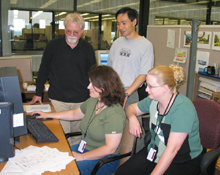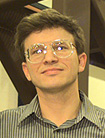 | Thursday, August 18, 2005 |
|
Thursday, August 18 3:30 p.m. Director's Coffee Break - 2nd Flr X-Over 4:00 p.m. Theoretical Physics Seminar - Curia II Speaker: J. Kersten, DESY Title: Running Neutrino Masses and Mixings in See-Saw Scenarios Note: There will be no Accelerator Physics and Technology Seminar today
Friday, August 19 |
|
Extended Forecast |
Secon Level 3 |
|
Thursday, August 18 Sante Fe Black Bean Soup Sloppy Joe $4.85 Stuffed Peppers $3.75 Sauteed Liver & Onions $3.75 Baked Ham & Swiss on Ciabatta Roll $4.75 California Pizza $3.50 Crispy Fried Chicken Ranch Salad $4.85 The Wilson Hall Cafe now accepts Visa, Master Card, Discover and American Express at Cash Register #1. |
|
Thursday, August 18 Dinner Tomatoes & Mozzarella Salad Sea Bass w/Lemon Shallot Butter Sautéed Corn, Peppers, & Bacon Peach Cobbler w/Cream Chantilly
Wednesday, August 24
Chez Leon Menu |
| Fermilab Today is online at: http://www.fnal.gov/today/ Send comments and suggestions to today@fnal.gov Fermilab Today archive Fermilab Today PDF Version Fermilab Result of the Week archive Fermilab Safety Tip of the Week archive Linear Collider News archive Fermilab Today classifieds Subscribe/Unsubscribe to |
|
Grids Help Search for Gravitational Waves Albert Einstein predicted the existence of gravitational waves in 1916, and for the past three decades a succession of experiments has attempted to directly detect the waves with no success. Now using the Laser Interferometer Gravitational Wave Observatory and grid computing, 400 scientists and engineers hope to finally detect them. Read More |
|
August 15 - August 17 - During this 48 hour period Operations established one store that combined with an existing store provided the experiments with 22 hours and 40 minutes of luminosity - Lithium lens repaired - TeV quench - F sector vacuum problem
Read the Current Accelerator Update |
|
From Australia's Radio National program PM, August 15, 2005 Professor Lisa Randall Talks of String Theory By Mark Colvin
A hundred years ago, in 1905, Albert Einstein released a series of scientific papers continuing some of his greatest work, including the Special Theory of Relativity.
|
| Could Asymmetry Provide Hints of A New Particle? |
||||||
|
||||||
|
The Standard Model (SM) has been very successful in describing the elementary particles and the interactions among them. In particular, experiments have confirmed that forces between the Z boson, photon, quarks and leptons are precisely prescribed by the so-called gauge symmetry of the SM.
At the Tevatron, Z bosons and photons are produced in quark anti-quark annihilations and can subsequently decay into electron-positron pairs. When an electron travels in the hemisphere defined by the direction of the incoming quark, the event is called forward; otherwise it is called backward. The measure of asymmetry, Afb, is defined as the ratio of the number of forward events minus the number of backward events, all divided by the total number of events. The SM predicts that the asymmetry depends on the invariant mass of the electron-positron pair (Mee). DZero physicists have analyzed events with electron-positron pairs to study Afb. Special emphasis has been put on the region of high mass, which is accessible only at the Tevatron—the world's highest energy accelerator. The asymmetry in this region is expected to be large and almost independent of the mass. A deviation from the predicted value of about 0.6 would indicate existence of an unknown particle interfering with the Z boson and photon. The current DZero results, based on data set of 172 pb-1, indicate good agreement with the SM predictions up to the mass of 350 GeV. More data are being analyzed that will allow a more precise determination of the forward-backward asymmetry and thus further scrutiny of the Standard Model. |
||||||
|
||||||
|
||||||
Result of the Week Archive |
||||||
|
ILC Newsletter Launches ILC NewsLine, the International Linear Collider Global Design Effort's newsletter, releases its inaugural issue today. Sign up for the newsletter at LinearCollider.org.
Building Manager Notice
Third Thursday Lunchtime Cleanup
Wisconsin Dells Coupon Book Sale |






